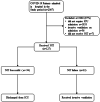Factors Associated With Non-invasive Oxygen Therapy Failure in COVID-19 Pneumonia: A Single Center, Retrospective Study in a Tertiary Hospital in North India
- PMID: 36340560
- PMCID: PMC9627106
- DOI: 10.7759/cureus.29721
Factors Associated With Non-invasive Oxygen Therapy Failure in COVID-19 Pneumonia: A Single Center, Retrospective Study in a Tertiary Hospital in North India
Abstract
Background: Non-invasive oxygen therapy (NIT) consists of high-flow nasal oxygen (HFNO) and continuous positive airway pressure (CPAP). NIT is routinely being used for the management of acute respiratory failure secondary to coronavirus disease-2019 (COVID-19) with variable outcomes. However, previously published studies show that NIT failure might delay endotracheal intubation and invasive mechanical ventilation and results in worse outcomes in patients with hypoxemic respiratory failure. Early prediction of failure of NIT, will help in early decision-making in initiating invasive mechanical ventilation. We retrospectively studied the predictors for NIT failure in patients with moderate to severe COVID-19.
Methods: Adult patients (>18 years) admitted to the intensive care unit (ICU) with moderate to severe COVID-19 ARDS and received NIT [HFNO and CPAP non-invasive ventilation (NIV)] were included in this study. Baseline clinical and laboratory data were collected retrospectively from the electronic hospital information system. NIT failure was defined as the need for invasive mechanical ventilation after the initiation of NIT in the ICU. Univariate and multivariate logistic regression analyses were used to find out the possible predictors of NIT failure.
Results: Out of 254 patients admitted to ICU, 127 patients were initiated NIT at admission to ICU. During the course of the ICU stay, 33 (26%) patients subsequently required invasive mechanical ventilation (NIT failure). Respiratory rate-oxygenation index (ROX index) of <2.97 at two hours and <3.63 at six hours of ICU admission predicted NIT failure in our cohort of patients with a high positive predictive value.
Conclusion: Patient selection is crucial for successful NIT in COVID-19. Application of ROX index measured in the first six hours of ICU admission helps in the identification of patients at risk of NIT failure with moderate to severe COVID-19 ARDS.
Keywords: continuous positive airway pressure (cpap); covid induced ards; covid-19; high flow nasal cannula (hfnc); invasive ventilation; non-invasive oxygen therapy; non-invasive ventilation; predictors of nit failure; rox index.
Copyright © 2022, L et al.
Conflict of interest statement
The authors have declared that no competing interests exist.
Figures



Similar articles
-
Analysis of combined non-invasive respiratory support in the first six waves of the COVID-19 pandemic. Outcome according to the first respiratory support.Trends Anaesth Crit Care. 2023 Feb;48:101208. doi: 10.1016/j.tacc.2022.101208. Epub 2022 Dec 23. Trends Anaesth Crit Care. 2023. PMID: 38620777 Free PMC article.
-
Breathing pattern, accessory respiratory muscles work, and gas exchange evaluation for prediction of NIV failure in moderate-to-severe COVID-19-associated ARDS after deterioration of respiratory failure outside ICU: the COVID-NIV observational study.BMC Anesthesiol. 2022 Oct 1;22(1):307. doi: 10.1186/s12871-022-01847-7. BMC Anesthesiol. 2022. PMID: 36183064 Free PMC article.
-
The Predictive Values of Respiratory Rate Oxygenation Index and Chest Computed Tomography Severity Score for High-Flow Nasal Oxygen Failure in Critically Ill Patients with Coronavirus Disease-2019.Balkan Med J. 2022 Mar 14;39(2):140-147. doi: 10.4274/balkanmedj.galenos.2021.2021-7-32. Balkan Med J. 2022. PMID: 35330565 Free PMC article.
-
High-flow nasal cannulae for respiratory support in adult intensive care patients.Cochrane Database Syst Rev. 2021 Mar 4;3(3):CD010172. doi: 10.1002/14651858.CD010172.pub3. Cochrane Database Syst Rev. 2021. PMID: 33661521 Free PMC article.
-
Comparison between high-flow nasal cannula and noninvasive ventilation in COVID-19 patients: a systematic review and meta-analysis.Ther Adv Respir Dis. 2022 Jan-Dec;16:17534666221113663. doi: 10.1177/17534666221113663. Ther Adv Respir Dis. 2022. PMID: 35861299 Free PMC article.
Cited by
-
The Impact of High-Flow Nasal Cannula Therapy on Acute Respiratory Distress Syndrome Patients: A Systematic Review.Cureus. 2023 Jun 30;15(6):e41219. doi: 10.7759/cureus.41219. eCollection 2023 Jun. Cureus. 2023. PMID: 37397646 Free PMC article. Review.
-
Effect of prophylactic noninvasive oxygen therapy after planned extubation on extubation failure in high-risk patients: a retrospective propensity score-matched cohort study.Front Med (Lausanne). 2024 Sep 26;11:1481083. doi: 10.3389/fmed.2024.1481083. eCollection 2024. Front Med (Lausanne). 2024. PMID: 39391038 Free PMC article.
References
-
- High flow nasal cannula compared with conventional oxygen therapy for acute hypoxemic respiratory failure: a systematic review and meta-analysis. Rochwerg B, Granton D, Wang DX, et al. Intensive Care Med. 2019;45:563–572. - PubMed
-
- Failure of high-flow nasal cannula therapy may delay intubation and increase mortality. Kang BJ, Koh Y, Lim CM, et al. Intensive Care Med. 2015;41:623–632. - PubMed
LinkOut - more resources
Full Text Sources
